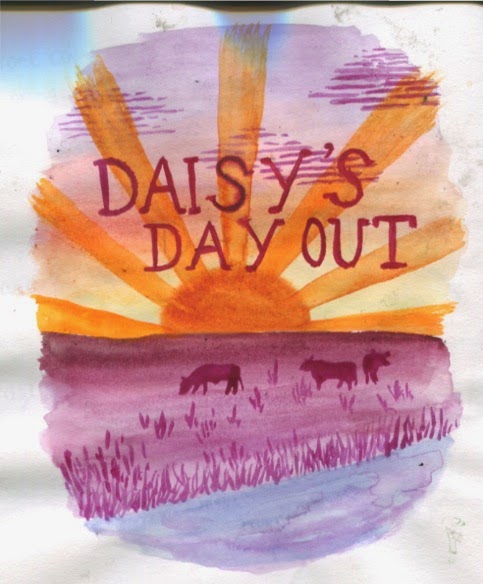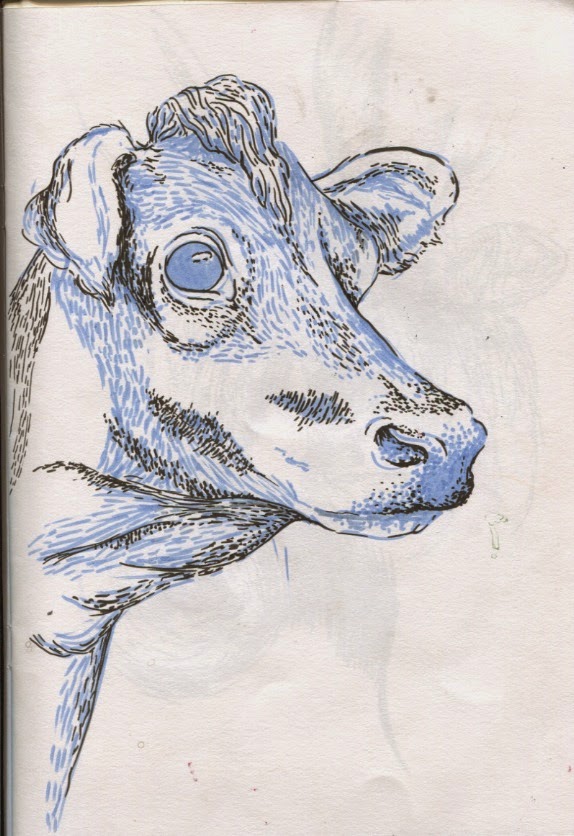Thinking what context my work will exist in has definitely developed the way I approach image making. When my work has a distinct purpose I find it easier to evaluate the way I am working and make critical decisions about how I should approach a piece of work. There were many problems with the way I approached making a book during Level 4 COP, and I used what I had learned from my mistakes last year to vastly improve the way I approached image making this year. I chose to make my book digitally rather than using traditional techniques to give a much cleaner and more professional look. I also used an actual font rather than hand drawn type, which I used last year, which proved to be quite hard to read when printed out on a small scale.
The narrative of my work was a definite strength. In the feedback tutorials I was told that the story linked well with my essay title and that the contrast between the naive children's style illustrations and the honest and brutal narrative worked really well. I was quite organised with my time and didn't leave anything to the last minute, I worked hard on getting the book finished to a high standard with plenty of time left to finish other aspects of the module. At the start of the project I initially wanted to create 3 books, but it was suggested that this would be too much work, so I decided to create only 1 book, but to a very high standard, I think this was my main improvement from last year, where I gave myself too much work to do, so I wasn't happy with the quality of the finished work.
I think the main weakness within this module was definitely my essay. Although I enjoyed doing the research, as the meat industry is something I'm quite interested in, I still found it hard to actually write the essay to a standard that I was pleased with, so I think it will affect my overall grade. I also found the study tasks quite hard, because I didn't blog them straight away, as I find analysing images difficult, and I was struggling to get back into the flow of analysing things after the end of Level 4, so I ended coming back to the study tasks a while after we had been briefed them, so the information we were given to support the tasks wasn't fresh in my mind. In hindsight I should have just approached Richard and asked for help with them, but at the time I felt like I was too busy with others modules to do this, so throughout Level 6 I will ask for help more often rather than leaving it and struggling when I come back to it.
During Level 6 I intend to:
The narrative of my work was a definite strength. In the feedback tutorials I was told that the story linked well with my essay title and that the contrast between the naive children's style illustrations and the honest and brutal narrative worked really well. I was quite organised with my time and didn't leave anything to the last minute, I worked hard on getting the book finished to a high standard with plenty of time left to finish other aspects of the module. At the start of the project I initially wanted to create 3 books, but it was suggested that this would be too much work, so I decided to create only 1 book, but to a very high standard, I think this was my main improvement from last year, where I gave myself too much work to do, so I wasn't happy with the quality of the finished work.
I think the main weakness within this module was definitely my essay. Although I enjoyed doing the research, as the meat industry is something I'm quite interested in, I still found it hard to actually write the essay to a standard that I was pleased with, so I think it will affect my overall grade. I also found the study tasks quite hard, because I didn't blog them straight away, as I find analysing images difficult, and I was struggling to get back into the flow of analysing things after the end of Level 4, so I ended coming back to the study tasks a while after we had been briefed them, so the information we were given to support the tasks wasn't fresh in my mind. In hindsight I should have just approached Richard and asked for help with them, but at the time I felt like I was too busy with others modules to do this, so throughout Level 6 I will ask for help more often rather than leaving it and struggling when I come back to it.
During Level 6 I intend to:
- Make sure that I am fully invested in whatever I choose to research, so that I can do my best both with the practical and essay side of the module.
- I will ask for help whenever I need it to avoid not doing something, coming back to it, and struggling more than I did in the first place.
- I will push myself to create as much work as possible to a high standard, now that I feel I have a better grasp of what my limits are, I can safely push them to challenge what I'm capable of.
- I will blog everything as I go along, and do a lot research into my Level 6 subject over the Summer so that I am well prepared for when we return.
- I want to try and gather more first hand research, rather than secondary, even if this is just photo reference imagery to help me with the practical tasks.





